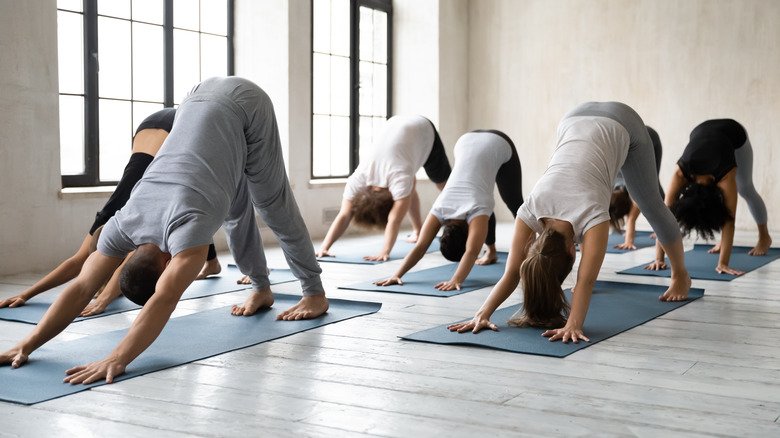Unlocking the Power of Yoga: A Guide to Mind, Body, and Soul Connection
Yoga, a practice with roots stretching back over 5,000 years in ancient India, has blossomed into a global phenomenon that promotes mental clarity, physical strength, and spiritual awareness. It’s more than just a series of poses; yoga offers a holistic approach to wellness by uniting the mind, body, and soul. Whether you’re looking to improve flexibility, reduce stress, or find inner peace, yoga has something for everyone.
In this blog post, we’ll explore the benefits of yoga, the different types of practices, and how to get started on your journey to a healthier, more balanced life.
Click Here To Get The Best Deal On Yoga Mats
The Benefits of Yoga
Yoga’s widespread appeal is largely due to its versatility and the range of benefits it offers. Here are some key benefits that make yoga an essential practice for people of all ages and backgrounds.
1. Improves Physical Health
Yoga is an excellent way to build strength, flexibility, and balance. Poses, or asanas, target different muscle groups, helping to stretch tight areas and build endurance. For example:
- Strengthens muscles: Yoga poses such as plank, warrior, and chair pose engage muscles, building strength over time.
- Improves flexibility: Regular yoga practice gradually improves flexibility, which can enhance posture, ease physical pain, and prevent injuries.
- Enhances balance and coordination: Poses that focus on balance, such as tree pose, improve coordination and stability, which can be especially beneficial as we age.
2. Promotes Mental Clarity and Focus
The mindfulness component of yoga encourages you to be present in the moment, improving your ability to focus and concentrate. Practicing yoga can help sharpen mental clarity and reduce distractions, which is especially helpful in our technology-driven world. Over time, yoga can enhance cognitive function and even improve memory.
3. Reduces Stress and Anxiety
Yoga is well known for its calming effect on the mind. The deep breathing techniques in yoga stimulate the parasympathetic nervous system, helping to reduce the body’s stress response. This can help lower levels of cortisol (the stress hormone) and promote relaxation.
For many, yoga also provides a mental break, a time to step back from life’s stressors. Meditation and mindfulness techniques practiced during yoga can provide long-term tools for managing anxiety and promoting peace of mind.
4. Boosts Emotional Health
Yoga isn’t just about physical flexibility; it also promotes emotional resilience. Practicing mindfulness and learning to control breathing helps calm the mind and foster a greater sense of self-awareness and self-acceptance. Yoga encourages positive thoughts and habits, often helping to improve mood and foster a more balanced emotional outlook.
Click Here To Get The Best Deal On Yoga Mats
5. Spiritual Growth and Self-Awareness
Yoga is a personal journey that can bring spiritual fulfillment and self-discovery. By connecting with the body and mind on a deeper level, yoga encourages introspection and can lead to a better understanding of oneself and one’s purpose. Many practitioners feel a sense of inner peace, compassion, and gratitude after a consistent practice.
Exploring Different Types of Yoga
One of the beautiful aspects of yoga is the variety of practices that exist. Whether you prefer a fast-paced, sweaty session or a gentle, meditative flow, there’s a type of yoga for you.
1. Hatha Yoga
Hatha yoga is an umbrella term that refers to all physical postures in yoga. It’s a gentle introduction to yoga and great for beginners as it focuses on slow and deliberate movements combined with breathing exercises. Hatha yoga is ideal for those looking to ease into yoga and build a foundation.
2. Vinyasa Yoga
Vinyasa, also known as “flow yoga,” connects breath with movement in a dynamic sequence. Each pose flows seamlessly into the next, creating a rhythm that feels like a moving meditation. This practice is energizing and ideal for those who enjoy an active, varied workout.
3. Ashtanga Yoga
Ashtanga is a more rigorous, structured form of yoga, consisting of six series of specific postures that increase in difficulty. It’s challenging both physically and mentally and is best suited for those who enjoy structure and discipline in their practice.
4. Bikram Yoga
Bikram yoga consists of a set sequence of 26 postures practiced in a heated room. The heat helps to increase flexibility, and the structured sequence allows practitioners to track their progress. Be prepared to sweat—this practice is intense and detoxifying.
5. Yin Yoga
Yin yoga is a slow, meditative practice that focuses on deep stretching and holding poses for an extended time. It targets the connective tissues, ligaments, and joints, making it ideal for those looking to improve flexibility and promote relaxation. Yin yoga is great for unwinding and finding stillness.
6. Restorative Yoga
As the name suggests, restorative yoga is all about relaxation and restoration. Poses are held for long periods, often with the support of props like blankets and blocks, to help release tension and promote relaxation. This practice is perfect for anyone looking to reduce stress and anxiety.
Click Here To Get The Best Deal On Yoga Mats
Getting Started: Tips for a Successful Yoga Journey
Starting yoga can feel a bit overwhelming, especially with so many styles and practices available. Here are some tips to help you get started:
- Start with the Basics: Begin with beginner classes or poses that focus on foundational movements. Hatha or Yin yoga are good options for newcomers.
- Listen to Your Body: Yoga is a personal journey, so respect your body’s limits and avoid pushing too hard. Remember, progress in yoga is gradual, and with consistency, strength and flexibility will develop naturally.
- Practice Mindfulness: Focus on your breath, and try to remain present in each pose. Yoga isn’t just about the physical movements; the mental component is just as important.
- Set a Routine: Consistency is key to reaping the benefits of yoga. Start with a few sessions a week and gradually build up your practice as you feel comfortable.
- Find a Qualified Instructor: If you’re new to yoga, attending a class or following a guided video can help ensure proper form and prevent injuries. Many yoga studios also offer online classes, making it convenient to practice from home.
- Create a Dedicated Space: If you’re practicing at home, set up a space for your yoga mat, blocks, and any other props you may need. Having a dedicated area can help create a peaceful environment for practice.
Final Thoughts
Yoga is a lifelong practice that offers endless benefits for the body, mind, and spirit. Whether you’re a complete beginner or a seasoned practitioner, yoga provides a path to wellness, self-discovery, and inner peace. The beauty of yoga is that it meets you wherever you are—whether you’re looking for strength, flexibility, stress relief, or a spiritual connection.
As you start or continue your yoga journey, remember that yoga is about the process, not the destination. With regular practice and an open heart, yoga can be a transformative experience that enhances every aspect of your life.



